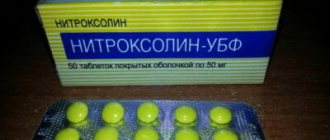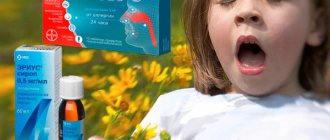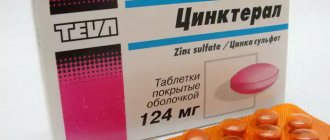Release form and composition
- coated tablets: biconvex, round, sugar coated, pink (20 pcs. in blisters, 1 blister in a cardboard box);
- solution for injection: colorless transparent liquid for parenteral administration (2 ml in dark glass ampoules, 6 ampoules in a cardboard box);
- syrup: liquid of sweet caramel taste, orange color (60 ml in dark glass bottles complete with a measuring pipette, 1 set in a cardboard box).
1 tablet contains:
- active ingredient: prifinium bromide – 30 mg;
- auxiliary components: starch, lactose, povidone, magnesium stearate, colloidal silicon dioxide, croscarmellose sodium, gelatin, talc, titanium dioxide, paraffin paraffin, carnauba wax, sucrose, FD&C red dye No. 3.
1 ml of solution for injection contains:
- active ingredient: prifinium bromide – 7.5 mg;
- auxiliary components: sodium chloride, hydrochloric acid, water for injection.
1 ml of syrup contains:
- active ingredient: prifinium bromide – 1.5 mg;
- auxiliary components: glycerin, propylene glycol, sodium benzoate, sucrose, liquid sorbitol, sodium citrate, sodium saccharin, monoammonium glycyrrhizinate, liquid caramel flavor, dyes: FD&C yellow No. 6 and FD&C red No. 40, purified water.
Pharmacological properties of the drug Riabal
A synthetic anticholinergic drug from the group of quaternary ammonium compounds. Riabal has a specific antispasmodic effect on the gastrointestinal, biliary and urinary tracts. Relieves pain from peptic ulcers of the stomach or duodenum, eliminates spasms of the urinary tract and accelerates the removal of stones from the urinary canal. After parenteral or oral administration, prifinium bromide is rapidly cleared from the blood serum. The half-life is 2.13 hours. The volume of distribution at steady state is approximately 190% of the patient's body weight, and the total serum clearance and renal clearance are 12.5 and 5.8 ml/(min • kg), respectively. About 50% of the drug is excreted unchanged in the urine.
Indications for use
- pain syndrome associated with increased peristalsis and spasms of the gastrointestinal tract (GIT), caused by acute inflammation of the gastric mucosa, exacerbation of chronic gastritis, gastric and duodenal ulcers, enterocolitis, irritable bowel syndrome;
- pain syndrome associated with spasms of the smooth muscles of the gallbladder and biliary dyskinesia caused by calculous cholecystitis, inflammation of the pancreas, pancreatitis;
- pain syndrome associated with spasm of the genitourinary tract caused by algodismenorrhea, urolithiasis, cystitis (inflammation of the bladder);
- pain in the epigastric region due to impaired function of the large intestine, accompanied by flatulence and symptoms of intestinal obstruction;
- vomiting, bloating, intestinal colic (spasms of smooth muscles of the gastrointestinal tract) in newborns and infants;
- organic gastrointestinal diseases, vomiting due to acute gastroenteritis, hyperthermia, intracranial hypertension, radiation therapy;
- instrumental and radiological examinations of the gastrointestinal tract (as a means of preliminary preparation before procedures).
Side effects
When using Riabal drugs, a number of adverse reactions may occur, among which patients are most often concerned about:
- dyspeptic disorders such as constipation, dry mouth and nausea;
- skin forms of allergies in the form of rash and itching, Quincke's edema and urticaria;
- changes in the functions of the cardiovascular system in the form of increased blood pressure and heart rate;
- headache;
- weakness and fatigue;
- urinary retention.
Contraindications
Contraindications to the use of Riabal are in one way or another related to its ability to influence the functioning of other organs and systems; it cannot be used for the following diseases of the heart and blood vessels:
- ciliated artymia;
- sinus tachycardia;
- IHD and CHF;
- mitral valve stenosis;
- hypertonic disease;
- bleeding in the acute stage, including gastrointestinal;
- hyperthermia.
It is not recommended to use the product in the presence of stones in the gallbladder, and the diameter of the formations exceeds the diameter of the ducts, in case of acute urinary retention, in the presence of megacolons and intestinal atony.
Contraindications to the use of the drug are also glaucoma, prostate adenoma and allergies to the components of the drug.
With great caution and only in case of vital indications, Riabal is prescribed for liver failure, achylia, reflux esophagitis, autonomic neuropathy, nonspecific ulcerative colitis and COPD.
Pregnancy
Pregnancy is not a contraindication to the use of Riabal, therefore women carrying a child can use the drug after prior consultation with their doctor.
During lactation, the use of the drug should be limited to cases where the benefit to the mother many times exceeds the potential risk to the nursing child.
Directions for use and dosage
Film-coated tablets Riabal tablets are taken orally.
Recommended dosage regimen depending on the patient's age:
- children 6-12 years old – 1 pc. (30 mg) 2-3 times a day;
- children over 12 years old and adults – 1-2 pcs. (30-60 mg) 3 times a day.
If necessary (to relieve severe acute pain), adults are allowed to take 3 tablets (90 mg) at a time.
Solution for injection Solution for injection Riabal is administered subcutaneously (SC), intravenously (IV) or intramuscularly (IM), depending on the indications.
Recommended average doses for adults:
- single dose – 15-30 mg (1-2 ampoules), maximum single dose – 90 mg (6 ampoules);
- daily – 45-90 mg (3-6 ampoules), maximum daily – 90 mg (6 ampoules);
- course - 450 mg (30 ampoules), maximum course - 900 mg (60 ampoules).
For children, Riabal injection solution can be administered from birth at 1 mg/kg body weight per day (s.c., i.v., i.m.).
The duration of therapy ranges from 7 to 15 days.
The IV solution should be administered slowly over 1 minute, because rapid administration of prifinium bromide can provoke a sharp drop in blood pressure and cause the development of a state of shock.
Riabal can be used intravenously in an isotonic aqueous solution of 0.9% sodium chloride.
Syrup Riabal syrup is taken orally.
Children over 12 years of age and adults are recommended to take 20-40 ml of syrup 3 times a day.
Recommended average doses for children over 12 years of age and adults:
- single dose – 15-30 mg, maximum single dose – 90 mg;
- daily – 45-90 mg, maximum daily – 90 mg;
- course - 450 mg, maximum course - 900 mg.
Recommended dosage regimen for children with a dosage frequency of 1 time every 6-8 hours:
- up to 3 months – 1 ml;
- 3-6 months – 1-2 ml;
- 6-12 months – 2 ml;
- 1-2 years – 5 ml;
- 2-6 years – 5-10 ml;
- 6-12 years – 10-20 ml.
The duration of therapy with Riabal syrup is from 7 to 15 days.
Price
The drug Riabal is relatively inexpensive, even though, depending on the name of the pharmacy chain and regions, its price fluctuates in the range of several tens of rubles or hryvnia.
Cost in Ukraine
In Ukrainian pharmacies you can buy the medicine from 27.5 to 44 hryvnia for a pack of 20 tablets.
Cost in Russia
In Russian pharmacies the drug costs an average of 280-295 rubles per pack of 20 tablets.
Video on the topic: Bloating and flatulence. Causes of the problem and how to get rid of it
Analogs
Analogues of Riabal are: Bebinos, Bromocriptine, Ganaton, Bimaral, Gaviscon, Digestal, Halidor, Domperidone, Gastenorm forte, Itomed, Carbopect, Gestid, Markalakt, Disflatil, Mezim forte, Iberogast, Metovit, Yogulakt, Milk of Magnesia, Maalox, Motonium, Metamol, No-shpa forte, Metoclopramide, Panzinorm Forte, Motilak, Penzital, Pancreatin, Rennie, Perinorm, Simikol, Sab simplex, Spasmonet, Smecta, Festal, Trimedat, Cholenzym, Hilak forte, Zeolate, Hofitol, Unienzim, Espumisan, No– spasm.
Showing
Pain, associated with spasms and promoted peristalsis of the herbal tract:
with gastritis, infection of the scutum and duodenum, enteritis, colitis, after gastrectomy and with bowel syndrome.
Pain associated with spasms and dyskinesia of the biliary ducts:
with cholecystitis, gum disease.
Pain with pancreatitis.
Pain with spasms of the vascular tract
: with the presence of concretions in the tract, with tenesmus of the tract, cystitis, pelitis.
Medication preparation before endoscopy of the pouch and pouch-intestinal radiography.
Dysmenorrhea.
Side effects
Especially with hypersensitivity, allergic reactions are rarely possible.
Dry mouth, blurred vision and impaired visual accommodation rarely occur and occur with a reduced dose or after discontinuation of the drug.
In some cases, the following side reactions may occur:
On the side of the immune system:
allergic reactions, including skin irritation, itching, hyperemia, urticaria, angioedema, reddened skin.
On the side of the scolio-intestinal tract:
boredom, vomiting, constipation, dry mouth.
On the side of the thyroid system:
zatrimka sechovipuskannya.
From the side of the organs:
loss of accommodation, blurred vision.
On the side of the nervous system:
headache, confusion, weakness, tremor.
On the side of the cardiovascular system:
flushing, tachycardia, arterial pressure, heart palpitations.
Contraindications
The pharmaceutical product is safe, but still, you should exercise some caution when using it. If you are allergic to any component of the syrup or tablets, it is better not to use them. The use of the drug for glaucoma is not recommended. If bleeding occurs in the stomach or intestines, it is necessary to stop taking medications, they can aggravate the patient's condition. If you have urinary retention, you should not take tablets or solution, as it may cause this problem.
Interactions with other medicinal drugs and other types of interactions
Priphenium bromide must be taken with care when taking low-value medications (see table).
| Likarsky estate | Signs, symptoms that celebration | Mechanism and factor riziku |
| Tricyclic antidepressants (imipramine; amitriptyline) Phenothiazini (chlorpromazine) Antihistamines (diphenylhydramine) | In connection with the anticholinergic action, there may be side reactions (impaired accommodative vision, dry mouth, impaired sechenogenesis). | The fragments of priphenium bromide and the prescribed drugs cause an anticholinergic effect, their infusion may be further potentiated. |
| Monoamine oxidase inhibitors | In connection with the anticholinergic action, there may be side reactions (impaired accommodative vision, dry mouth, impaired sechenogenesis). | As the drug metabolizes, the anticholinergic action may be reduced. |
The anticholinergic action of the drug may be potentiated by one-hour administration of antihistamines, tricyclic antidepressants, neuroleptics of the group similar to phenothiazine, disopyramide.
It has the effect of narcotic analgesics, antidepressants, antipsychotic drugs, neuroleptics, antiparkinsonian and anticholinergic drugs.
How does it affect the body?
The drug has a positive effect on the body, its main task is to prevent vomiting or stomach cramps. Suppression of gag reflexes is possible thanks to M-cholinergic receptors. If you block this receptor, you can reduce the volume of saliva secretion. When the activity of the salivary glands is inhibited, the stomach produces juice less often, this is due to the pancreas, it begins to work more slowly. The result of this effect on the receptor is a decrease in normalization in the fibers of the digestive tract and emptying. To treat gastrointestinal diseases, medications are taken orally. The advantage of this remedy is its instant absorption and rapid reach of the disease sites. The medicine is safe for use, because it does not contain unnecessary toxic materials that can aggravate the patient’s situation. It is not poisonous and does not pollute the stomach or kidneys. Does not cause severe effects on the liver. The medical product is excreted independently through the urinary system. Due to its non-toxicity, it is used in the treatment of children, but a doctor must prescribe the drug to the child.
Contraindicated
List of contraindications for patients with the following illnesses:
- glaucoma: symptoms may be due to the ligament of the internal eye;
- Disorders of the prostate, causing prostate hypertrophy: Disorders of the prostate may subside, as a result of which the relaxation of the detrusor muscles and the shortening of the sphincter muscles of the prostate muscle are stimulated;
- Serious heart disease: symptoms may subside, causing the heart rate to speed up;
- paralytic intestinal obstruction: symptoms may subside, resulting in peristalsis of the intestinal tract;
- Sensitivity to any component of the drug has been increased.
Overdose
Symptoms:
if the average therapeutic dose is exceeded 100 times, there may be hallucinations, a curare-like effect (suppressed breathing).
Likuvannya:
rinsing the mouthpiece, soaking in weak salt mixture to cause diarrhea. Administer 1-2 mg of physostigmine salicylate internally, internally or subcutaneously to control the influx of anticholinergic agents into the central and peripheral nervous system. Whenever necessary, carry out individual ventilation of the leg.
Features of good stagnation
Taking drugs with anticholinergic activity can lead to a shift in the internal pressure.
With care, the drug should be taken if the following illnesses are evident: on the side of the cardiovascular system - migratory arrhythmia, tachycardia, chronic heart failure, mitral stenosis, arterial hypertension, acute hemorrhage, in case of any diseases An increase in heart rate may soon become undesirable; in cases of thyrotoxicosis, elevated body temperature, reflux esophagitis, hernia of the anterior diaphragm with reflux esophagitis, achalasia and hilar stenosis, intestinal atony in patients of late age or weakened illnesses, paralytic intestinal obstruction, liver or nitric insufficiency; chronic illnesses, especially in children of young age and weakened illnesses; myasthenia, autonomic neuropathy, gestosis; deteriorated brain in children, Down syndrome, central palsy in children.
In patients with prostatic hypertrophy, anticholinergic effects can cause a decrease in the maximum pressure in the musculoskeletal region, an increase in the maximum volume of the vascular muscle and sometimes lead to increased dysuria.
Priphenium bromide should be administered with caution to patients with hyperthyroidism, as they usually have accelerated heart disease or tachycardia, and the associated symptoms may worsen.
It is necessary to treat patients with congestive heart failure with caution, as the heart rate may accelerate and symptoms may worsen.
It is necessary to administer medication with care to patients with viral colitis in case of possible development of toxic megacolon.
Priphenium bromide must be administered with caution to patients who are aware of the influx of high temperatures into the excess fluid, fragments of the secretion system, such as sweat glands and body thermoregulation, may be affected This is due to hyperthermia.
In connection with the anticholinergic action of the drug, it is necessary to carefully confuse the presence of bromide in patients with summer age, as it is possible that symptoms such as impaired accommodation of the eye, dryness of the eyes may appear. roti or damage to the secretion (div. section “Adverse reactions”).
The doctor's prescription includes lactose, so if the patient has an intolerance to certain lactoses, consult a doctor first and take this drug first.
Suspension during pregnancy or breastfeeding.
Vaginism:
The safety of bromide for pregnant women has not been prescribed.
Taking the drug during pregnancy or breastfeeding is only possible if the woman’s measles are removed and there is a potential risk for the fetus/child.
This is due to the fluidity of the reaction during treatment with vehicles or other mechanisms.
This may cause disturbances in zoral accommodation, which should be avoided in patients who engage in potentially unsafe activities that are hazardous, such as carpooling or using other machinery. isms.




